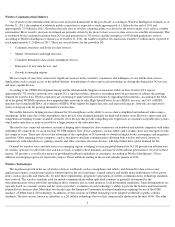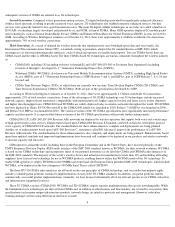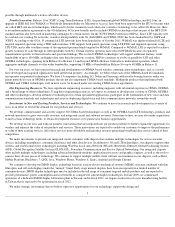Qualcomm 2011 Annual Report Download - page 18
Download and view the complete annual report
Please find page 18 of the 2011 Qualcomm annual report below. You can navigate through the pages in the report by either clicking on the pages listed below, or by using the keyword search tool below to find specific information within the annual report.
served as Executive Vice President and President of QCT from August 2008 to September 2010, as Executive Vice President, QCT Product
Management from May 2008 to July 2008, as Senior Vice President, Engineering and Product Management from July 2006 to May 2008 and as
Vice President, Engineering from April 2002 to July 2006. Mr. Mollenkopf joined Qualcomm in 1994 as an engineer and throughout his tenure
at Qualcomm held several other technical and leadership roles. Effective November 14, 2011, Mr. Mollenkopf will become President and Chief
Operating Officer. Mr. Mollenkopf holds a B.S. degree in Electrical Engineering from Virginia Tech and an M.S. degree in Electrical
Engineering from the University of Michigan.
Donald J. Rosenberg, age 60, has served as Executive Vice President, General Counsel and Corporate Secretary since October 2007. He
served as Senior Vice President, General Counsel and Corporate Secretary for Apple Computer, Inc. from December 2006 to October 2007.
From May 1975 to November 2006, Mr. Rosenberg held numerous positions at IBM Corporation, including Senior Vice President and General
Counsel. Mr. Rosenberg holds a B.S. degree in Mathematics from the State University of New York at Stony Brook and a J.D. from St. John’s
University School of Law.
Daniel L. Sullivan, age 60, has served as Executive Vice President of Human Resources since August 2001. He previously served as Senior
Vice President of Human Resources from February 1996 to July 2001. Dr. Sullivan holds a B.S. degree in Communication from Illinois State
University, an M.A. degree in Communication from West Virginia University and a Ph.D. in Communication from the University of Nebraska.
Jing Wang, age 49, has served as Executive Vice President and President of Global Business Operations since January 2011. He served as
Executive Vice President and President of Asia Pacific, Middle East and Africa from January 2008 to January 2011. Mr. Wang previously
served as Chairman, Qualcomm Asia Pacific from August 2006 to January 2008 and as Chairman, Qualcomm Greater China from March 2003
to August 2006. He joined Qualcomm as Senior Vice President in February 2001. Mr. Wang holds a B.A. degree in Literature from Anhui
University, an LL.M from the People’s University of China, Department of Law, and an LL.M from the University of Virginia School of Law.
Item 1A. Risk Factors
You should consider each of the following factors as well as the other information in this Annual Report in evaluating our business and our
prospects. The risks and uncertainties described below are not the only ones we face. Additional risks and uncertainties not presently known to
us or that we currently consider immaterial may also impair our business operations. If any of the following risks actually occur, our business
and financial results could be harmed. In that case, the trading price of our common stock could decline. You should also refer to the other
information set forth in this Annual Report, including our financial statements and the related notes.
Risks Related to Our Businesses
Our revenues are dependent on the commercial deployment of technologies based on CDMA and OFDMA, among others, and upgrades of
2G, 3G and 3G/4G multimode wireless communications equipment, products and services based on these technologies.
We develop, patent and commercialize technology and products based on CDMA and OFDMA, among others. Our revenues are dependent
upon the commercial deployment of these technologies and products and upgrades of 2G, 3G and 3G/4G multimode wireless communications
equipment, products and services based on these technologies. Our business may be harmed, and our investments in these technologies may not
provide us an adequate return if:
Our business is dependent on our ability to increase our share of components sold and to continue to drive the adoption of our products and
services into 3G, 3G/4G multimode and 4G wireless devices and networks. We are also dependent on the success of our customers, licensees and
CDMA- and OFDMA-based wireless operators and other industries using our technologies, as well as the timing of their deployment of new
services, and they may incur lower gross margins on products or services based on these technologies than on products using alternative
technologies as a result of greater competition or other factors. If commercial deployment of these technologies, upgrade of 2G subscribers to 3G
devices and upgrades to 3G, 3G/4G multimode or 4G wireless communications equipment, products and services based on these technologies do
not continue or
13
• wireless operators delay moving 2G customers to 3G devices;
• wireless operators delay 3G and/or 3G/4G multimode deployments, expansions or upgrades;
• government regulators delay the reallocation of 2G spectrum to allow wireless operators to upgrade to 3G, which will restrict the
expansion of 3G wireless connectivity, primarily outside of major population areas;
• wireless operators are unable to drive improvements in 3G network performance and/or capacity;
• LTE, an OFDMA-based wireless standard, is not widely deployed or commercial deployment is delayed; or
• wireless operators and other industries using these technologies deploy other technologies.
























